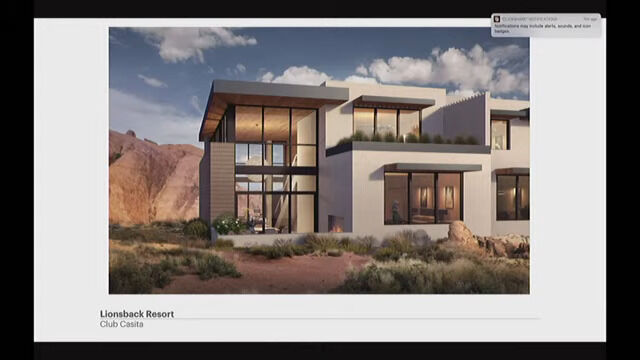The Lionsback Resort development, located on land owned by the Utah School and Institutional Trust Lands Administration adjacent to the Sand Flats Recreation Area, has been in the works since the mid-2000s. The project has been highly controversial, generating fears about the spring protection area within the Lionsback property that feeds into Skakel Springs, a source of area drinking water, and generating two lawsuits.
The lawsuits were eventually resolved and the project began in earnest last year, when the developers, LB Moab Land LLC, began work to bring utilities to the property. The master development plan has already received preliminary approval, and the City Planning Commission unanimously recommended that the council give final approval.
A public hearing on the development was held at the June 8 city council meeting before the council voted 4-1 to approve the final master development plan, as well as the final plat for Phase I of development and a subdivision improvement agreement.
Moab City Planner Nora Shepard reviewed the history of the project and brought council members and the public up to date on where it currently stands.
48 acres of the 175-acre property are intended to be developed, with 257 lodging units planned. This includes 50 hotel suites, 179 casitas of varying sizes and designs, and 18 employee housing units to be built over five phases.
The first phase includes 34 casitas and a 50-unit hotel, though the developers are starting with the casitas only.
Developers have reached a water source protection agreement with the City of Moab and Jon Dwight of LB Moab noted in a presentation that access to the Hell’s Revenge trail as well as the Mill Creek trail will remain open to the public. He added that the company intends to preserve as many juniper trees as possible during construction.
“A big intent is to maintain natural vegetation in landscaping,” Dwight noted. “We hope to actually become a leader in the community with our water conservation program.”
Within the resort, roads will have a speed limit of 15 miles per hour and be designed to welcome all modes of transportation including pedestrians and bikes. Lighting will follow dark night-sky ordinances.
Councilmember questions
Councilmember Rani Derasary asked which party would be held liable if there was any contamination of the groundwater. City Engineer Chuck Williams explained that the city would identify the contaminant and its source, and the entity which was responsible for the contaminant would hold liability.
In other words, if the Lionsback Development were found to have caused contamination of the area feeding into Skakel Spring, the developers would be held responsible.
Dwight emphasized that the drinking water source protection plan is “the backbone of everything. It’s been a really critical piece to a lot of people in the community, including us.”
Derasary also noted that two substantial components of the Lionsback proposal had not been included in the council’s agenda packet until the last minute, and members of the public may not have had time to review them. She suggested postponing a vote on the issue until the next council meeting, but other councilmembers pointed out that the development has been discussed for years and they felt comfortable taking the vote that night.
“Every day I have been on council—every single day—Lionsback has been in front of us,” said Councilmember Tawny Knuteson-Boyd. “Two more weeks is not going to change my mind.”
Councilmember Kalen Jones expressed concerns about the employee housing units, noting that the 18 units included in the development plan amount to only about half of what would be required by the city’s Workforce Assured Housing Opportunities Ordinance. The WAHOO was passed after Lionsback already had vested rights, and so the resort is not required to comply, but Jones noted that the disparity between the plans and what WAHOO would require if it applied suggests that the 18 units won’t be enough.
“It is something for the developer to take into consideration when they get to the building of the housing,” said City Attorney Laurie Simonson. The employee housing is scheduled to be included in Phase V of the development; Dwight indicated that it may be moved to an earlier phase.
Jones noted that the new overnight lodging units included in the resort will in turn generate an increased demand for workforce housing. He expressed a wish for more workforce housing, and for it to be built sooner than phase 5 of the development, though he acknowledged that the city does not have leverage to require this from the developer.
Public opinion
Despite years of vocal public opposition, comments made during the public hearing were largely in support of the development.
“When it first came on board, to be honest I wasn’t exactly thrilled,” Moab resident Howard Trenholme said of the project, acknowledging that at that time he was skeptical of any kind of development. “But over the 20 years it’s almost taken to bring this thing to fruition… I believe the developer has gone above and beyond what is required, and seeing the plans, I was blown away.”
Local business leaders like Joe Kingsley and real estate agent Billy Snyder also spoke in favor of the project.
The master development plan, final plat of Phase I and subdivision improvement agreement were approved 4-1, with Rani Derasary opposed due to procedural concerns regarding the late-added exhibits before the public hearing.




